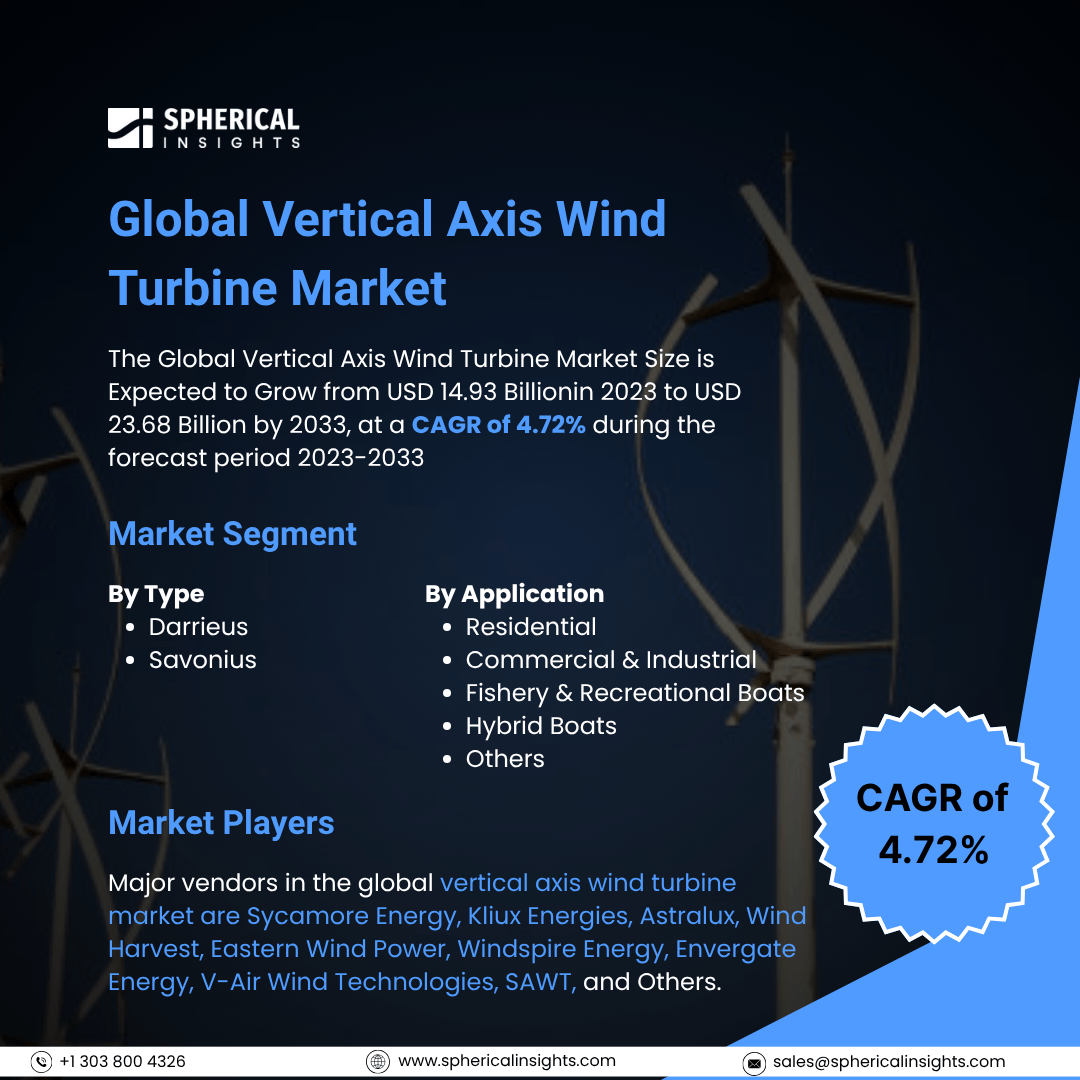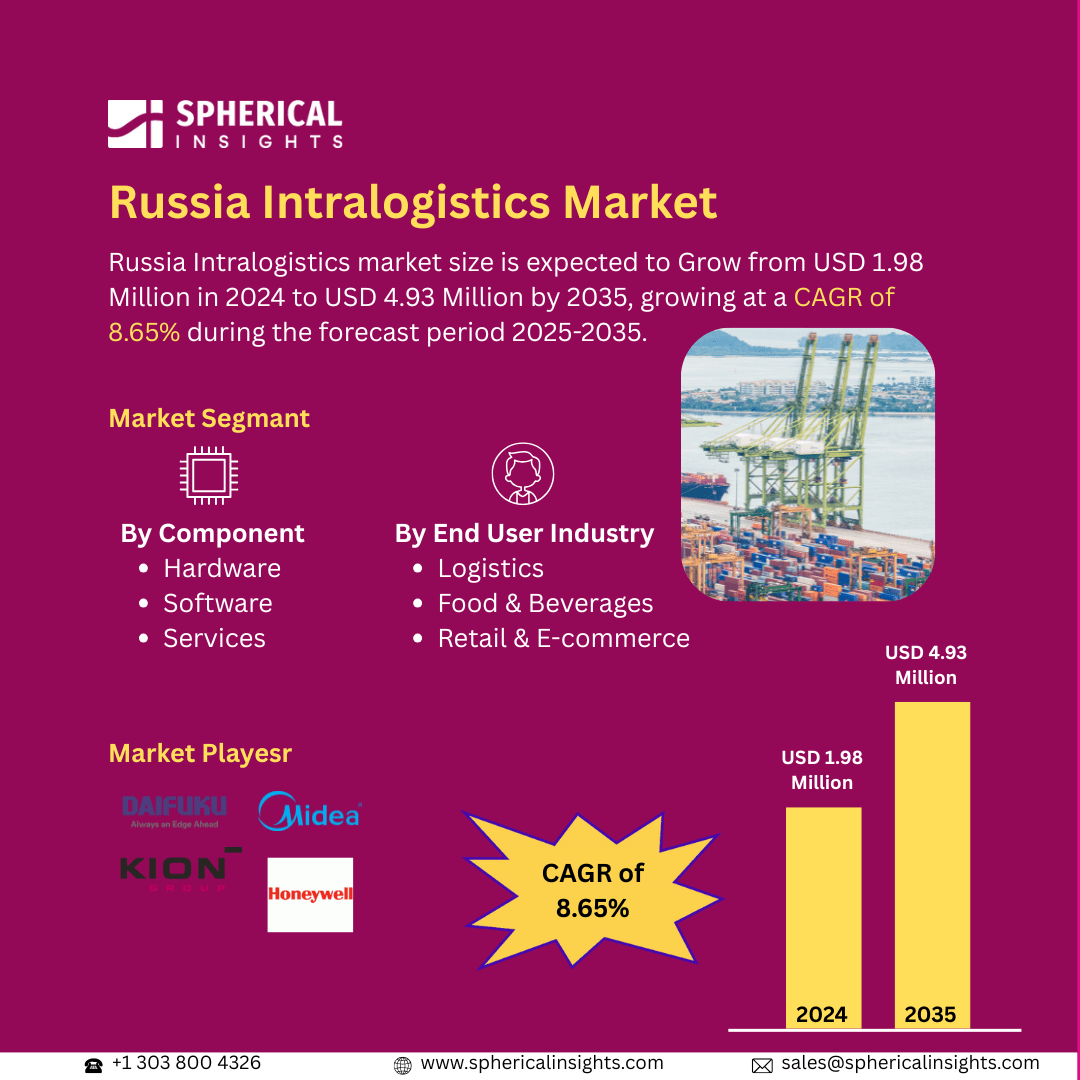Global Vertical Axis Wind Turbine Market Size to Exceed USD 23.68 Billion by 2033
According to a research report published by Spherical Insights & Consulting, The Global Vertical Axis Wind Turbine Market Size is Expected to Grow from USD 14.93 Billion in 2023 to USD 23.68 Billion by 2033, at a CAGR of 4.72% during the forecast period 2023-2033.
Browse 210 market data Tables and 45 Figures spread through 190 Pages and in-depth TOC on the Global Vertical Axis Wind Turbine Market Size, Share, and COVID-19 Impact Analysis, By Type (Darrieus and Savonius), By Application (Residential, Commercial & Industrial, Fishery & Recreational Boats, Hybrid Boats, and Others), and By Region (North America, Europe, Asia-Pacific, Latin America, Middle East, and Africa), Analysis and Forecast 2023 – 2033
The global vertical axis wind turbine market refers to the industry that is committed to the global manufacture, advancement, distribution, and adoption of vertical axis wind turbines. VAWTs are capable of collecting wind energy from any direction because of their vertical rotor design, setting them apart from conventional horizontal-axis wind turbines (HAWTs). Technological developments, prominent manufacturers, market trends, demand patterns, investment opportunities, regulatory policies, and regional market dynamics are just a few of the many facets that make up this industry. Key driving factors for the growth of the vertical-axis wind turbine market include the increasing utilization of renewable energy, government subsidies, innovative technology, and designs that save space. Decentralized power generation, growing urbanization, and sustainability objectives all increase demand, which makes VAWTs a crucial component in the expansion of clean energy. However, the reduced efficiency of VAWTs is in comparison to conventional HAWTs, particularly when it involves large-scale energy generation.
The Darrieus segment accounted for the largest revenue share in 2023 and is projected to grow at a significant CAGR during the forecast period.
On the basis of type, the global vertical axis wind turbine market is divided into Darrieus and Savonius. Among these, the Darrieus segment accounted for the largest revenue share in 2023 and is projected to grow at a significant CAGR during the forecast period. The regional growth can be attributed to high power production, longevity, and efficiency across a range of wind speeds. Technological developments, expanding urban wind energy projects, and sustainability programs all contribute to the market's growth.
The commercial & industrial segment accounted for the largest market share in 2023 and is anticipated to grow at a remarkable CAGR during the forecast period.
On the basis of application, the global vertical axis wind turbine market is divided into residential, commercial & Industrial, fishery & recreational boats, hybrid boats, and others. Among these, the commercial & industrial segment accounted for the largest market share in 2023 and is anticipated to grow at a remarkable CAGR during the forecast period. The segment growth is driven because of growing demands for energy, cost-effectiveness, and sustainability. By using VAWTs for decentralized power generation, businesses may reduce their demand for conventional energy sources.
Asia Pacific is anticipated to hold the largest share of the global vertical axis wind turbine market over the predicted timeframe.
Asia Pacific is anticipated to hold the largest share of the global vertical axis wind turbine market over the predicted timeframe. The regional market growth can be attributed encouraged by the government's strong support for renewable energy, increasing energy consumption, and rapid industrialization. Moreover, advantageous legislation, advances in technology, and growing sustainability programs, countries like China and India are making significant investments in wind energy projects.
North America is expected to grow at the fastest CAGR in the global vertical axis wind turbine market during the forecast period. The regional market growth is driven because to increasing urbanization, government incentives, and technological developments. Further, the small dimensions, VAWTs are appropriate for spaces with restricted space, and growing environmental consciousness and carbon reduction objectives are promoting their use in commercial, residential, and industrial settings, which is propelling market expansion.
Company Profiling
Major vendors in the global vertical axis wind turbine market are Sycamore Energy, Kliux Energies, Astralux, Wind Harvest, Eastern Wind Power, Windspire Energy, Envergate Energy, V-Air Wind Technologies, SAWT, and Others.
Key Target Audience
- Market Players
- Investors
- End-users
- Government Authorities
- Consulting and Research Firm
- Venture capitalists
- Value-Added Resellers (VARs)
Recent Development
- In September 2024, RE Technologies GmbH introduced the 4.2M160 wind turbine generator. Designed for low to medium wind segments, this turbine features a 160-meter rotor and hub heights up to 140 meters. It incorporates advanced control technologies and adaptive systems to optimize performance in varying environmental conditions. Manufactured in collaboration with Senvion India, the 4.2M160 emphasizes local supply chain integration and sustainability
Market Segment
This study forecasts revenue at global, regional, and country levels from 2023 to 2033. Spherical Insights has segmented the global vertical axis wind turbine market based on the below-mentioned segments:
Global Vertical Axis Wind Turbine Market, By Type
Global Vertical Axis Wind Turbine Market, By Application
- Residential
- Commercial & Industrial
- Fishery & Recreational Boats
- Hybrid Boats
- Others
Global Vertical Axis Wind Turbine Market, Regional
- North America
- Europe
- Germany
- Uk
- France
- Italy
- Spain
- Russia
- Rest of Europe
- Asia Pacific
- China
- Japan
- India
- South Korea
- Australia
- Rest of Asia Pacific
- South America
- Brazil
- Argentina
- Rest of South America
- Middle East & Africa
- UAE
- Saudi Arabia
- Qatar
- South Africa
- Rest of the Middle East & Africa



